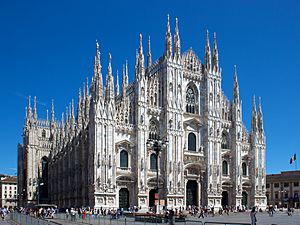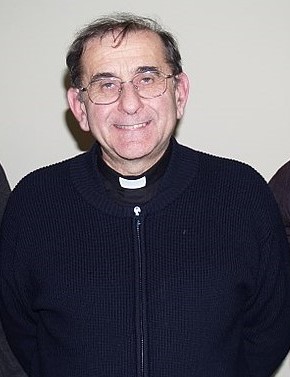Roman Catholic Archdiocese of Milan facts for kids
Quick facts for kids Archdiocese of MilanArchidioecesis Mediolanensis Arcidiocesi di Milano |
|
|---|---|

The Milan Cathedral
|
|
| Location | |
| Country | Italy |
| Statistics | |
| Area | 4,243 km2 (1,638 sq mi) |
| Population - Total - Catholics |
(as of 2021) |
| Parishes | 1,107 |
| Information | |
| Denomination | Catholic |
| Sui iuris church | Latin Church |
| Rite |
|
| Established | 1st century (diocese) 374 (archdiocese) |
| Cathedral | Cattedrale di S. Maria Nascente |
| Secular priests | 1,712 (diocesan) 738 (Religious Orders) 156 Permanent Deacons |
| Current leadership | |
| Pope | Francis |
| Archbishop | Mario Delpini |
| Auxiliary Bishops |
|
| Emeritus Bishops |
|
| Map | |
 |
|
The Archdiocese of Milan is a very important part of the Catholic Church in Italy. It covers the areas of Milan, Monza, Lecco, and Varese. This archdiocese is special because it uses its own unique way of worship, called the Ambrosian rite. This rite is still used in most of its churches.
Some famous leaders of this archdiocese include Ambrose, Charles Borromeo, Pope Pius XI, and Pope Paul VI. The Archdiocese of Milan is the largest in Europe. It also has the most priests in the world. As of 2021, there were 2,450 priests living there.
Contents
A Look at History
How the Church Began in Milan
Legend says that the Christian message came to Milan from Barnabas, one of Jesus's apostles. The first Bishop of Milan, Anathalon, was said to be his student. However, the church in Milan probably started around 200 AD. This was after the Roman Empire changed its local government areas.
During the 200s and early 300s, many Christians in Milan faced tough times. They were persecuted for their faith. Some, like Gervasius and Protasius, became martyrs. This means they died for their beliefs. The persecutions ended in 313 AD. This was when the emperors Constantine I and Licinius issued the Edict of Milan. This important rule allowed everyone in the Roman Empire to practice their religion freely.
Important Leaders and Challenges
The church in Milan has always been connected to the Papacy, which is the office of the Pope. Some early bishops stood up against powerful Roman emperors. For example, Dionysius was sent away in 355 AD for his strong beliefs.
A very famous bishop was Ambrose. He was chosen by the people of Milan in 374 AD. He led the church for many years. Later, during the Lombard invasion, the bishop and many clergy had to leave Milan for a while. They returned about 70 years later.
In the 10th century, the archbishops of Milan became very powerful. They even controlled large areas of northwest Italy. One of the most important was Ariberto da Intimiano. But as cities grew stronger, the power of the archbishops slowly decreased.
Modern Times and Papal Connections
A key figure in the modern history of the Milan church was Charles Borromeo. He was archbishop from 1564 to 1584. He played a big role in the Counter-Reformation. This was a time when the Catholic Church made many important changes.
In the 20th century, two archbishops of Milan became Pope! In 1922, Cardinal Achille Ratti was elected as Pope Pius XI. Then, in 1963, Cardinal Giovanni Battista Montini became Pope Paul VI. These connections show the importance of the Archdiocese of Milan.
Current Leadership
As of July 7, 2017, the main leader of the Archdiocese of Milan is Archbishop Mario Enrico Delpini. He was chosen by Pope Francis. Before becoming archbishop, he served as a Vicar-General and Auxiliary Bishop. Archbishop Delpini took over from Cardinal Angelo Scola.
Archbishop Delpini works with several Auxiliary Bishops. These bishops help him manage the large archdiocese.
Training for Priests
The main training center for priests in the archdiocese is in Venegono Inferiore. Younger students who want to become priests study at the minor seminary in Seveso.
Notable Bishops and Archbishops
A list of the bishops and archbishops of Milan is carved on a plaque in the Cathedral of Milan. Here are some of the most well-known leaders throughout history:
Early Leaders
- Anathalon (first bishop)
- Mirocles (attended an important council in 313 AD)
- Dionysius (exiled for his beliefs)
- Ambrose (374–397, a very influential figure)
- Dacius (530–552, lived in exile due to war)
Middle Ages Leaders
- John the Good (641–669, brought the clergy back to Milan)
- Ariberto da Intimiano (1018–1045, a powerful archbishop)
- Ottone Visconti (1262–1295, established the Visconti family's rule)
Modern Leaders
- Cardinal Carlo Borromeo (1564–1584, led major church reforms)
- Cardinal Federico I Borromeo (1595–1631)
- Cardinal Giuseppe II Pozzobonelli (1743–1783)
- Cardinal Ambrogio Damiano Ratti (1921–1922, became Pope Pius XI)
- Cardinal Giovanni Battista Montini (1954–1963, became Pope Paul VI)
- Cardinal Carlo Maria Martini (1979–2002, a well-known modern leader)
- Cardinal Angelo Scola (2011–2017)
- Mario Delpini (2017–Present)
Church Locations
The Archdiocese of Milan has 1,104 parishes, which are local church communities. All of these parishes are located within the Lombardy region of Italy. They are spread across several provinces, including Province of Bergamo, Province of Como, Province of Lecco, Province of Milan, Province of Pavia, and Province of Varese.
See also
- Ambrosian chant
- Ambrosian Rite
- Cathedral of Milan
- Angelo Scola
- Early Christian churches in Milan
Images for kids



